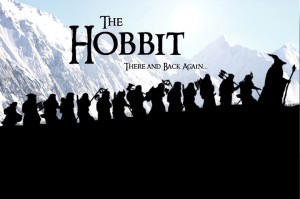 As many of you might have guessed, there were a couple of stories posted today that were a few facts shy of truthfulness, courtesy of your very tricksy TORn staff on the occasion of April Fools Day. Currently, Warner Bros has no plans to move the release date of “The Hobbit: There and Back Again” to July 2015 or any other date, and no, Peter Jackson has not hired Leonard Nimoy to reprise his “Ballad of Bilbo Baggins” song for the closing credits. We also had a little fun over on the message boards, highlighted by this post by DanielLB. Turns out there were April Fools jokes all over the inter webs today, and even a few with actual advertising, such as the Cheeteau perfume, that smells like Cheetos. None for me, thank you very much. A quick google search should come up with some of the best, but this reporter rather liked the the PBS report on Dolphins shooting rainbows out of their beaks, or Westjet converting to Metric time and giving you a mathematical equation to figure out the time conversion. So if you were scratching your head, wondering if something we said was true or not, rest assured that the two stories mentioned above were not true, but the interview with Luke Evans and the spoiler analysis from Cinemacon were true. And if you would like a walk down memory lane to April Fools past, you can find them on the TORn Mathom-house Wiki.
As many of you might have guessed, there were a couple of stories posted today that were a few facts shy of truthfulness, courtesy of your very tricksy TORn staff on the occasion of April Fools Day. Currently, Warner Bros has no plans to move the release date of “The Hobbit: There and Back Again” to July 2015 or any other date, and no, Peter Jackson has not hired Leonard Nimoy to reprise his “Ballad of Bilbo Baggins” song for the closing credits. We also had a little fun over on the message boards, highlighted by this post by DanielLB. Turns out there were April Fools jokes all over the inter webs today, and even a few with actual advertising, such as the Cheeteau perfume, that smells like Cheetos. None for me, thank you very much. A quick google search should come up with some of the best, but this reporter rather liked the the PBS report on Dolphins shooting rainbows out of their beaks, or Westjet converting to Metric time and giving you a mathematical equation to figure out the time conversion. So if you were scratching your head, wondering if something we said was true or not, rest assured that the two stories mentioned above were not true, but the interview with Luke Evans and the spoiler analysis from Cinemacon were true. And if you would like a walk down memory lane to April Fools past, you can find them on the TORn Mathom-house Wiki.
And for anyone wondering why Garfield the Cat is being used here, the answer lies in my nickname.
Posted in:
Share:

 In shocking news, Warner Bros. today announced that the release of The Hobbit: There And Back Again will be pushed back so the final film of Bilbo Baggins’ adventure can premiere at Comic-Con in July 2015. The new worldwide release date is July 29, 2015.
In shocking news, Warner Bros. today announced that the release of The Hobbit: There And Back Again will be pushed back so the final film of Bilbo Baggins’ adventure can premiere at Comic-Con in July 2015. The new worldwide release date is July 29, 2015.
Premieres during Comic-Con International in San Diego are nothing new. “The 300” premiered in Petco Park a few years ago, heralded by bare-chested Spartans throughout the week-long convention. “Cowboys and Aliens” also held their premiere in San Diego during the convention, with DreamWorks booking an theater complex for the event.
This was an April Fool gag, and is not a true story. It is false, and all details have been invented. We hope that everyone enjoyed the joke.
Early details hint that Jackson and Warner Bros. are planning something on an even-larger scale: a massive week-long Middle-earth-themed carnival of events and activities that turn TABA’s debut into “the largest-ever world premiere of a film”. We’ve also noted that it sets Warner Bros. up for a strong one-two punch at the box office with the release of Pan just two weeks earlier.
Readers will, of course, recall that the date for The Hobbit: There And Back Again has, already been pushed back once from July to December 2014. I think we can all sincerely hope that this is the last shift in date for the film!
The official press release follows:
“The Hobbit: There and Back Again” to be released July 29, 2015 and will premiere at Comic-Con International
Continue reading “The Hobbit: There and Back Again release date pushed back to premiere at Comic-Con in July 2015”
Posted in:
Share:

 Calling all Middle-earth artists! To celebrate the upcoming Home Video release of The Hobbit: The Desolation of Smaug, we here at TheOneRing.net have got together with Warner Bros. to bring you an exciting COMPETITION — ‘Show us your passion for Smaug’!
Calling all Middle-earth artists! To celebrate the upcoming Home Video release of The Hobbit: The Desolation of Smaug, we here at TheOneRing.net have got together with Warner Bros. to bring you an exciting COMPETITION — ‘Show us your passion for Smaug’!
What do you have to do?
We know you love the unassessably wealthy one — as Peter Jackson and his team realized him on the big screen. We want to see that passion poured into your own homage to the Greatest of Calamities! You might choose to paint, sketch, embroider or sculpt (or even bake!) your Smaug — the only restriction is that it must be original art created with your own fair hands (so no computer generated wyverns, please!). Then send us a photo (or three) of your Smaug homage for a chance to win some great prizes!
Who can enter?
Continue reading “Show us your passion for Smaug — COMPETITION TIME!”
Posted in:
Share:

 Blu-ray.com has posted their review of the 2D Blu-ray release of The Hobbit: The Desolation of Smaug. High marks are given for both video (4.5 out of 5) and audio quality (5 out of 5) – and we also get a closer glimpse at what bonus features are offered on this Theatrical Blu-ray/DVD edition.
Blu-ray.com has posted their review of the 2D Blu-ray release of The Hobbit: The Desolation of Smaug. High marks are given for both video (4.5 out of 5) and audio quality (5 out of 5) – and we also get a closer glimpse at what bonus features are offered on this Theatrical Blu-ray/DVD edition.
Of particular note is the inclusion of last year’s The Desolation of Smaug Live Event, as well as a collection of trailers for the film (both of which were previously unadvertised for this release). Continue reading “Blu-ray.com reviews ‘The Hobbit: The Desolation of Smaug’ 2D Blu-ray release”
Posted in:
Share:

 For those hoping for more pick-ups for The Hobbit, it seems as though we’ve reached the end. In an interview in Las Vegas, Richard Armitage indicated that filming was complete, with only motion capture and ADR work left to be done.
For those hoping for more pick-ups for The Hobbit, it seems as though we’ve reached the end. In an interview in Las Vegas, Richard Armitage indicated that filming was complete, with only motion capture and ADR work left to be done.
Continue reading “No pick-up filming as Jackson prepares to farewell Middle-earth”
Posted in:
Share:

 People hoping for a big reveal about The Hobbit: There and Back Again at CinemaCon 2014 will probably come away disappointed by the news that, well, there wasn’t much news at all on that front.
People hoping for a big reveal about The Hobbit: There and Back Again at CinemaCon 2014 will probably come away disappointed by the news that, well, there wasn’t much news at all on that front.
Warner Bros. closed out their 2.30pm presentation with a special recorded message from Peter Jackson, then rolled a new production diary. Continue reading “CinemaCon Hobbit presentation reveals (un)-surprisingly little”
Posted in:
Share:

 As many of you might have guessed, there were a couple of stories posted today that were a few facts shy of truthfulness, courtesy of your very tricksy TORn staff on the occasion of April Fools Day. Currently, Warner Bros has no plans to move the release date of “The Hobbit: There and Back Again” to July 2015 or any other date, and no, Peter Jackson has not hired Leonard Nimoy to reprise his “Ballad of Bilbo Baggins” song for the closing credits. We also had a little fun over on the message boards, highlighted by this post by DanielLB. Turns out there were April Fools jokes all over the inter webs today, and even a few with actual advertising, such as the Cheeteau perfume, that smells like Cheetos. None for me, thank you very much. A quick google search should come up with some of the best, but this reporter rather liked the the PBS report on Dolphins shooting rainbows out of their beaks, or Westjet converting to Metric time and giving you a mathematical equation to figure out the time conversion. So if you were scratching your head, wondering if something we said was true or not, rest assured that the two stories mentioned above were not true, but the interview with Luke Evans and the spoiler analysis from Cinemacon were true. And if you would like a walk down memory lane to April Fools past, you can find them on the TORn Mathom-house Wiki.
As many of you might have guessed, there were a couple of stories posted today that were a few facts shy of truthfulness, courtesy of your very tricksy TORn staff on the occasion of April Fools Day. Currently, Warner Bros has no plans to move the release date of “The Hobbit: There and Back Again” to July 2015 or any other date, and no, Peter Jackson has not hired Leonard Nimoy to reprise his “Ballad of Bilbo Baggins” song for the closing credits. We also had a little fun over on the message boards, highlighted by this post by DanielLB. Turns out there were April Fools jokes all over the inter webs today, and even a few with actual advertising, such as the Cheeteau perfume, that smells like Cheetos. None for me, thank you very much. A quick google search should come up with some of the best, but this reporter rather liked the the PBS report on Dolphins shooting rainbows out of their beaks, or Westjet converting to Metric time and giving you a mathematical equation to figure out the time conversion. So if you were scratching your head, wondering if something we said was true or not, rest assured that the two stories mentioned above were not true, but the interview with Luke Evans and the spoiler analysis from Cinemacon were true. And if you would like a walk down memory lane to April Fools past, you can find them on the TORn Mathom-house Wiki.


 In shocking news, Warner Bros. today announced that the release of The Hobbit: There And Back Again will be pushed back so the final film of Bilbo Baggins’ adventure can premiere at Comic-Con in July 2015. The new worldwide release date is July 29, 2015.
In shocking news, Warner Bros. today announced that the release of The Hobbit: There And Back Again will be pushed back so the final film of Bilbo Baggins’ adventure can premiere at Comic-Con in July 2015. The new worldwide release date is July 29, 2015.

 For those hoping for more pick-ups for The Hobbit, it seems as though we’ve reached the end. In an interview in Las Vegas, Richard Armitage indicated that filming was complete, with only motion capture and ADR work left to be done.
For those hoping for more pick-ups for The Hobbit, it seems as though we’ve reached the end. In an interview in Las Vegas, Richard Armitage indicated that filming was complete, with only motion capture and ADR work left to be done. People hoping for a big reveal about The Hobbit: There and Back Again at CinemaCon 2014 will probably come away disappointed by the news that, well, there wasn’t much news at all on that front.
People hoping for a big reveal about The Hobbit: There and Back Again at CinemaCon 2014 will probably come away disappointed by the news that, well, there wasn’t much news at all on that front.